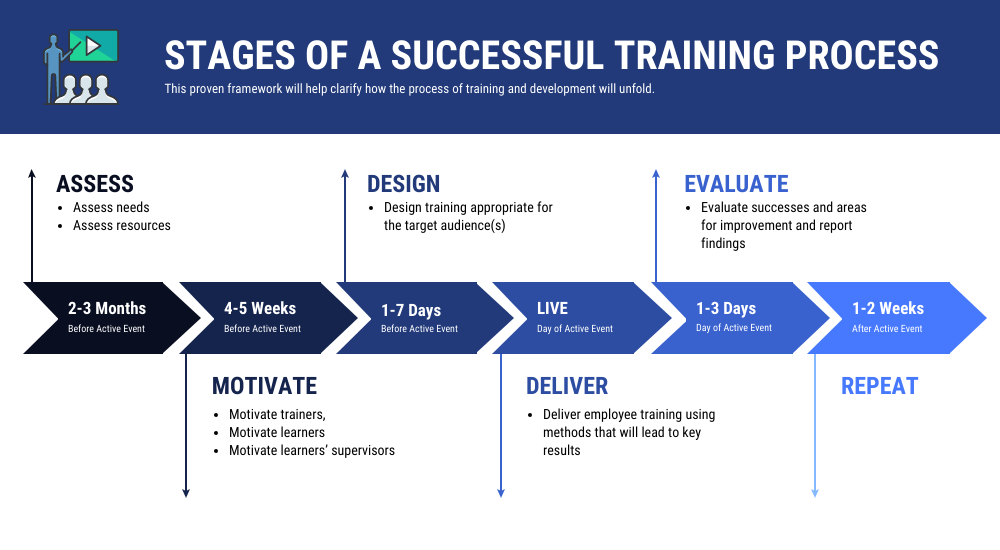Introducing new technologies to your business can boost productivity and efficiency. However, it can be challenging to train employees to adopt these tools, platforms, and systems—especially if they don’t feel particularly ‘tech-savvy’.
With more people working from home than ever before, this challenge has become increasingly prominent, especially as organizations were forced to conduct training virtually in order to keep their workers safe in the midst of the raging pandemic. For most people, especially those who aren't comfortable with new technology, this change can be difficult. There might be some pushback and feelings of inadequacy, all of which is completely normal.
But you can't afford to have employees feel held back by technology. With the right approach, motivation, and tools, you can ease the potential difficulties of virtual employee training and improve the way you do business.
In this post, I'm going to share some concrete strategies you can use to provide a positive, inclusive, and accessible online training experience for even the least tech-savvy members of your staff.
Why you should be training your non-tech-savvy employees online
Regardless of the industry you work in, you cannot do away with online training in today's digital world. Taking advantage of learning management systems to curate virtual learning and training sessions can help drive your business towards its goals, since online solutions are far more cost-effective and convenient:
- You don't have to spend a lot of money renting a training space, hiring qualified instructors, or handling logistics for employees to attend in-person training programs. They can just go online, log into the training management platform, and learn from wherever they are.
- Employees don't need to disrupt their hectic schedules or suffer productivity loss to complete their training, either; with self-directed and asynchronous courses, they can pace themselves and do their learning anytime that's suitable for them.
Sitting and listening to someone lecture for hours can get very dull quickly, causing employees to zone out and lose track of the message. But with fun digital learning formats like interactive quizzes, videos, and infographics, employees will be engaged and more enthusiastic to learn.
They're also more likely to remember most of what they learn and retain that information for longer. To top it off, online learning is easier to roll out and scale.
This is particularly useful when managing a remote workforce with employees based in different locations. Online training allows you to develop and deliver learning content to members of your organization no matter where they are.
Strategies to train non-tech savvy employees
Knowing how to train workers who are intimidated by or resistant to technology is critical, not just to the success of your business, but also to employee satisfaction and retention. After all, in our survey of 600 American learners, respondents' mean rating to indicate the importance of learning and training opportunities to their job satisfaction was 84 out of 100. Here are some proven techniques that can help make online training a breeze for employees across the board.
1. Leverage an easy-to-use LMS
The learning management system you use can make or break your training efforts. So the first thing you need to do is pick a platform that’s user-friendly, easy to navigate, and suitable for your particular needs.
You don’t want a situation where your employees face technical difficulties during learning. Since they’re already tech-avoidant, anything that goes wrong could disrupt the flow of the training program and plunge them into confusion or panic.
The learning platform you choose should be simple enough for both administrators and non-tech savvy employees to use. If you’re already having trouble setting it up and understanding how it works from the get-go, chances are your employees will experience the same issues.
Ideally, the LMS you opt for should be ready to use right away. It should require little or no extra work to get it up and running. Be sure to pick one with robust customer support that can step in and answer any questions you might have or resolve potential issues as they arise.
Related: 6 Long-Term Benefits of LMS Software
2. Focus on useful features
The learning curve for non-tech savvy employees is likely to take more time, and the best way to cut down on that is by choosing an LMS with a clean UI and minimal features. You don’t need a platform with lots of bells and whistles that you’re probably never going to use.
It might seem like a great deal and first, but it could end up just confounding learners. Stick to a powerful LMS that has all the essential features you want packed into a straightforward interface.
For instance, your learning management system should have a discussion forum function so employees can interact with each other and leave feedback while learning. It should also have a customizable homepage that allows you to adequately guide learners to training courses, Learning Needs, updates, and other important information.
4. Offer learning material in bite-sized chunks
Think of all the blog posts, articles, and reports you saved to read for later but never returned to. Or the videos you started watching but stopped only a few minutes in because it was too long to sit through.
That’s the same way most people react to long content, especially those not strictly for entertainment. After winning the hard war of getting your non-tech savvy employees to use your learning management system, the last thing you want is to overwhelm them or lose their attention.
Long onboarding videos, courses, and sessions can have this effect, so make sure you break them up into small, digestible pieces. This way, you can increase learner engagement and help them quickly assimilate and find information when needed.
Related: Microlearning Examples and Techniques to Improve Employee Learning Outcomes
5. Don’t make assumptions on their level of understanding
If you try to guess how familiar the audience is with a certain technology or subject matter, you might end up alienating them before they get a chance to find their feet. To avoid this, you need to start from the basics.
Figure out what parts of your learning management system need to be understood to enable users to gain sufficient mastery of the platform. Take that information and break it down into smaller steps that all employees can easily assimilate.
Although it might feel like you’re spoon-feeding them, this detailed breakdown can help energize employees who are disconnected from tech and make it easier for them to absorb the information.
6. Provide support
Your work doesn’t end after choosing a learning management system that’s easy to use. There’ll always be some people who need a little extra hand-holding as they navigate the online learning terrain.
For example, employees tend to need more guidance in a remote work culture. So if your company or startup leverages remote work, you need to focus on providing continuous growth-minded mentorship to employees during training sessions and beyond.
Start by giving employees detailed guides on how to use your chosen LMS and how to resolve common issues they may encounter. Emphasize that it’s okay to ask for help and that you’re there to support them at all times.
Appoint someone, preferably a member of your IT department or a tech-savvy employee, as the go-to person for any training-related questions or issues. Let your workers know when and how to contact this person if they run into any problems.
7. Analyze your training data and refine your program
By tracking your employees’ online training experience, you can deduce what’s working and what needs to be tweaked or changed. This will equip you to take quick action to eliminate any bottlenecks that may discourage people from using the learning platform or finishing the training.
Survey your employees to find out what they think about the learning management system and training program. Ask them what changes they would recommend making to improve their learning experience in the future.

Check your LMS analytic reports to gain a better understanding of how employees are engaging with the training. Are they completing the required courses? Did the training improve their knowledge of the subject matter? How well are they performing in terms of retaining what they’ve learned?
The insights you gain from these reports can prove invaluable to your training program, and ultimately, to your business.
Related: 3 Data-Based Ways To Prove Training ROI (+ Free Training ROI Calculator)
8. Focus on cross-skilling
Cross-skilling is the process of training employees in multiple skill sets and job roles that extend beyond their specific job functions or skills. It means that instead of training professionals in their areas of specialization alone, you’ll also train them in various basic technology and non-tech skills.
By adopting this strategy early on in your organization, you can drastically reduce the number of non-tech savvy people amongst staff members. You’ll also make it easier for non-tech employees to adopt new technology-based solutions and processes as they’re introduced.
9. Prioritize learning across all departments
The best way to prepare your company for potential opportunities that can accelerate growth and success is to invest in employee education at all levels actively.
One way to accomplish this is by aligning learning objectives with overall sales objectives. This means that the training programs you create and the technology you adopt should feed your bottom line directly or indirectly.
Charge each department with the responsibility of choosing the tech they use or intend to use to do their jobs and communicating the reason behind that decision to other teams.
You can also entrench this learning culture by organizing regular lunch and learn events involving everyone at the company. Specialists from different teams can share their expertise, improved processes and educate their coworkers on new skills, products, solutions, or trends.
The friendly environment will make employees more open-minded to new changes and ideas, including technical updates and online training.
Related: Your Ultimate Guide to Building a Learning Organization
Make employee training a breeze
That some members of your staff don’t have a flair for technology doesn’t mean that they can’t come to appreciate it or reap the rewards it has to offer. It just means that you need to sell it to them more convincingly.
Combining a well-planned online training strategy with the right learning management system can significantly improve your training process and engage personnel who are less likely to be technically proficient.



